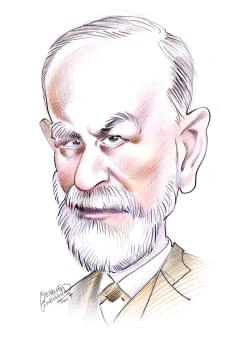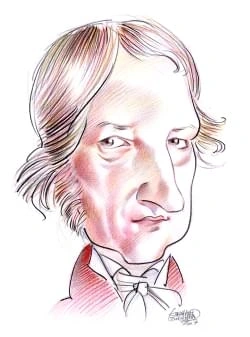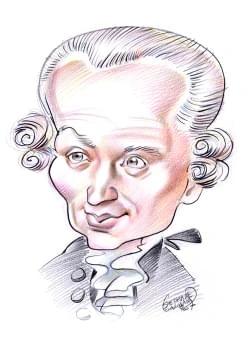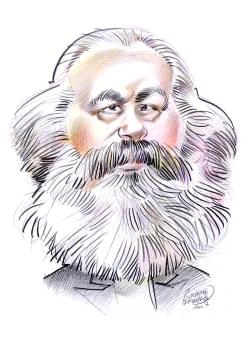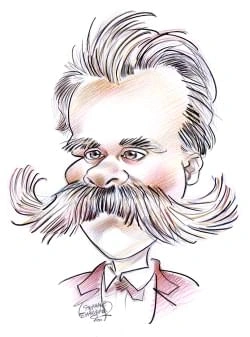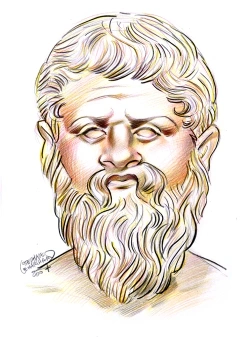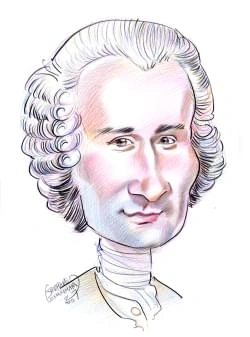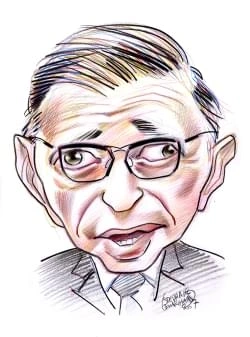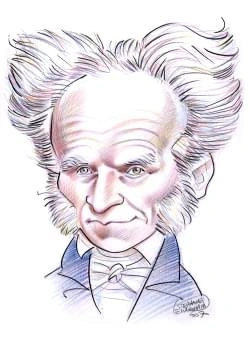656 résultats pour "work"
-
Peter Ilyich Tchaikovsky
I
INTRODUCTION
Peter Ilyich Tchaikovsky
Peter Ilyich Tchaikovsky's work combined Russian and European influences.
The period of his connection with von Meck was one of rich productivity for Tchaikovsky. To this time belong the operas Eugene Onegin (1879), The Maid of Orleans (1881), Mazeppa (1884), and The Sorceress (1887); the ballets Swan Lake (1877) and The Sleeping Beauty (1890); the Violin Concerto in D Major (1878) and the Piano Concerto No. 2 in G Major (1881); the orchestral works Marche Slave (1876), Symphony No. 4 in F Minor (1878), Capriccio Italien (1880), Serenade (1881), the 1...
-
James Joyce
I
INTRODUCTION
James Joyce
The works of Irish writer James Joyce are
Odysseus’s wife, Penelope. The 18 chapters of Ulysses parallel episodes from the Odyssey, but there are crucial differences between the two books. For instance, most interpretations of the Odyssey credit Penelope with fidelity during her husband’s lengthy absence, while Molly Bloom is unfaithful to her husband. As in Portrait, each chapter in Ulysses has a distinct style that reflects both the exterior and interior lives of the characters and their development as individuals. The fina...
-
Literary Criticism
I
INTRODUCTION
Literary Criticism, discussion of literature, including description, analysis, interpretation, and evaluation of literary works.
IV THE 17TH AND 18TH CENTURIES The climate of criticism changed with the arrival on the literary scene of such giants as Miguel de Cervantes, Lope de Vega, and Pedro Calderòn in Spain; WilliamShakespeare, Ben Jonson, and John Milton in England; and Pierre Corneille, Jean Baptiste Racine, and Molière in France. Most of these writers specialized or excelled indrama, and consequently the so-called battle of the ancients and moderns—the critical comparison of Greek and Roman authors with more rece...
-
Mark Twain
I
INTRODUCTION
Mark Twain, pseudonym of Samuel Langhorne Clemens (1835-1910), American writer and humorist, whose best work is characterized by broad, often irreverent humor
or biting social satire.
father, who keeps him prisoner in an isolated cabin. The boy escapes and, together with a runaway slave, Jim, sails down the Mississippi on a raft. During their trip,Huck and Jim encounter many unusual characters, including two families involved in a senseless feud and a pair of scoundrels who swindle innocent townspeople. Theirexperiences bring about a strong friendship between the boy and the slave, but their adventures end when Jim is captured and held at the farm of Tom Sawyer’s AuntSally. W...
-
Galileo
I
INTRODUCTION
Galileo (1564-1642), Italian physicist and astronomer who, with German astronomer Johannes Kepler, initiated the scientific revolution that flowered in the work of
English physicist Sir Isaac Newton.
V WORK IN ASTRONOMY During most of his time in Padua, Galileo showed little interest in astronomy, although in 1595 he declared in a letter that he preferred the Copernican theory that Earthrevolves around the Sun to the assumptions of Aristotle and Ptolemy that planets circle a fixed Earth ( see Astronomy: The Copernican Theory ; Ptolemaic System). A Observations with the Telescope In 1609 Galileo heard that a telescope had been invented in Holland. In August of that year he constructed a t...
-
Machine
I
INTRODUCTION
Machine, simple device that affects the force, or effort, needed to do a certain amount of work.
to decrease the amount of force needed to do work or to change the direction of the force. The wheel and axle and some levers can also be used to increase the speedof performance of a task, but doing so always increases the amount of force needed. A Inclined Plane NutsNuts are pieces of metal with a hole in the middle. They are screwed on the end of a bolt as a fastening. Nuts come invarying shapes, depending on their intended use.© Microsoft Corporation. All Rights Reserved. Ramps and staircas...
-
Francisco José de Goya y LucientesIINTRODUCTIONFrancisco de GoyaOne of the great masters of Spanish art, painter and illustrator Francisco José de Goya y Lucientes produced works ofconsiderable beauty and power.
Gallery, Washington, D.C.) show that Goya was then painting in an elegant manner somewhat reminiscent of the style of his English contemporary ThomasGainsborough. IV ETCHINGS AND LATER PAINTINGS Third of May, 1808Third of May, 1808 was painted by Spanish artist Francisco de Goya in 1814. His purpose was to commemorate theSpanish war of liberation, during which a number of innocent civilians were shot by soldiers from Napoleon’s army. At thislate stage in Goya’s career, he had become cynical...
-
German Literature
I
INTRODUCTION
German Literature, literature written in the German language from the 8th century to the present, and including the works of German, Austrian, and Swiss authors.
Till EulenspiegelThe medieval peasant Till Eulenspiegel appears in many German folktales as a trickster who outwits people in positions ofauthority. In this image his first name is spelled Tyll.Keystone Pressedienst GmbH The rise of the middle class in the 14th and 15th centuries and the struggles of the peasants against the nobility culminated in the great 16th-century religiousrevolution known as the Reformation. This movement was reflected in literature, especially by Martin Luther, whose tra...
-
-
Native American Art
I
INTRODUCTION
Native American Art, the visual works crafted by indigenous people of North America, starting after their arrival on the continent thousands of years ago and continuing
until the present.
artists in the Ohio area cut delicate flat forms from sheets of mica in the shape of birds, human figures, and large hands. They also carved quite natural-looking birdsand animals on stone platform pipes. These figures sat on the pipe’s flat base, or platform, and on some pipes they were part of the pipe bowl. Prominent people ofthese cultures were buried with a wealth of ornaments, such as jewelry of shells and copper, and headdresses elaborated with animal forms. The period of Mississippian cu...
- Nathaniel Hawthorne I INTRODUCTION Nathaniel Hawthorne (1804-1864), American novelist, whose works are deeply concerned with the ethical problems of sin, punishment, and atonement.
- Walt Whitman I INTRODUCTION Walt Whitman (1819-1892), American poet, whose work boldly asserts the worth of the individual and the oneness of all humanity.
- work
-
Art, performing
performers in instancing their work is not to say merely that performers are means for the work's transmission. Thefoundry workers who follow the sculptor's instructions and the film's projectionist help to create or transmit thework, but theirs is not the pivotal role of the performer. They might be replaced by technologically superioralternatives without thereby altering the artistic character of the statue or film, whereas the performer's task isineliminably part of works created fo...
-
Artistic expression
standard way. As a result of realizing that a character in a work is dying unloved one feels sadness for and pitytowards that character. Or, believing that the dramatic potential of the last act was botched by the playwright,one feels disappointed by the play. Or one is delighted by the felicity of a turn in the melody. In the second case,one tends to respond with sadness to works called sad, or with happiness to works said to express happiness.Something in the work calls forth the reaction...
- Gene Kelly Gene Kelly (1912-1996), American tap and ballet dancer, choreographer, actor, and director, known for his work in motion-picture musicals.
-
Artistic forgery
pieces, including pure music, where expressiveness is present in the absence of a narrated or depicted content.Whose emotions are expressed thereby and how are they expressed? 3 Arousal theory One suggested answer to the above question is that we ascribe emotions to art works just because those emotions are awakened in us. This is the theory of emotivism or arousalism. Two cases need to bedistinguished. In the first, the art work or some aspect of it is the emotional object of a response in...
-
-
Artistic interpretation
that a musical passage leads back to the tonic key is to describe it non-interpretively, but to explain it simply as abridge passage is to interpret it, however obviously. 2 Meaning Most theorists of literary criticism agree that the interpretation of literature aims to disclose meanings in texts.They disagree about the ground of such meaning, whether it is simply the semantic conventions of the language,the intentions of authors, or the interpretive activities of readers or critics. But i...
-
Decision engineering
Competitor’s resources. Threat and opportunities from within and without cross impact and external political. Besides, theses changement should be done step by step not sudden, because it’s difficult to change suddenly the things that’s happen today, we should learn the experience caused by it. So, the most important things to do to establish those changements are to consider the future and perspective necessary to correct the mistakes done in the past...
-
Comment faire du commerce en France
age. France being a part of the so called“Old Continent” is considered a country which has one of the longest and most influential histories. Moreover, the French people are well known for their pessimism and their complaining about the present or the future. Conflicts&Synergies We can take the example of “the age of retirement” as the people nowadays have to work longer than the previous generation in all these three countries, or the fact of losing certain social benefits, as it is in ...
-
Metropolitan Museum of Art.
B Ancient Near Eastern Art The objects in this department range from a vast geographical area in southwest Asia and northeast Africa from around 5000 BC to around AD 600. Notable works include Assyrian reliefs from the palace of King Ashurnasirpal II at Calah (now Nimrud, Iraq), Sumerian sculpture, Anatolian ivories, Iranian bronzes, and Achaemenidand Sassanian works in silver and gold. C Arms and Armor This department is renowned for its collection of European armor from the Middle Ages (5t...
-
Ludwig van Beethoven
I
INTRODUCTION
Ludwig van Beethoven
Ludwig van Beethoven is considered possibly the greatest Western composer of all time.
the other hand, breaks up the opening theme into contrasting segments in different tempi, whereas customary practice called for stating the theme in its entirety at thebeginning of a movement. In the first movement of the Eroica Symphony, one of the major works from Beethoven’s middle period, he again sought ways to expand upon the prevailing musical forms. At that time, composers usually organized movements in three major parts. First, the exposition introduces the musical themes of the pie...
-
Rembrandt.
myth that the painting was rejected by those who commissioned it, and led to a decline in Rembrandt's reputation and fortune, it was actually well received. Many of Rembrandt's landscapes in this middle period are romantic and based on his imagination rather than recording specific places. The inclusion of ancient ruins androlling hills, not a part of the flat Dutch countryside, as in River Valley with Ruins (Staatliche Gemäldegalerie, Kassel), suggests a classical influence derived from Italy...
-
Ludwig van Beethoven
I
INTRODUCTION
Ludwig van Beethoven (1770-1827), German composer, considered one of the greatest musicians of all time.
dedication after learning that Napoleon had taken the title of emperor. Beethoven’s other instrumental works from the period of the Eroica also tend to expand the formal framework that he inherited from Haydn and Mozart. The Piano Sonata in C major op. 53 ( Waldstein ) and the Piano Sonata in F minor op. 57 ( Appassionata ), completed in 1804 and 1805 respectively, each employ bold contrasts in harmony, and they use a broadened formal plan, in which the meditative slow movements flow directly...
-
Ludwig van Beethoven.
dedication after learning that Napoleon had taken the title of emperor. Beethoven’s other instrumental works from the period of the Eroica also tend to expand the formal framework that he inherited from Haydn and Mozart. The Piano Sonata in C major op. 53 ( Waldstein ) and the Piano Sonata in F minor op. 57 ( Appassionata ), completed in 1804 and 1805 respectively, each employ bold contrasts in harmony, and they use a broadened formal plan, in which the meditative slow movements flow directly...
-
-
Isaac NewtonIINTRODUCTIONIsaac Newton (1642-1727), English physicist, mathematician, and natural philosopher, considered one of the most important scientists of all time.
B Calculus (Newton’s “Fluxional Method”) In 1669 Newton gave his Trinity mathematics professor Isaac Barrow an important manuscript, which is generally known by its shortened Latin title, De Analysi . This work contained many of Newton’s conclusions about calculus (what Newton called his “fluxional method”). Although the paper was not immediately published, Barrowmade its results known to several of the leading mathematicians of Britain and Europe. This paper established Newton as one of the...
-
Isaac Newton.
B Calculus (Newton’s “Fluxional Method”) In 1669 Newton gave his Trinity mathematics professor Isaac Barrow an important manuscript, which is generally known by its shortened Latin title, De Analysi . This work contained many of Newton’s conclusions about calculus (what Newton called his “fluxional method”). Although the paper was not immediately published, Barrowmade its results known to several of the leading mathematicians of Britain and Europe. This paper established Newton as one of the t...
-
William Faulkner
I
INTRODUCTION
William Faulkner
Twentieth-century American novelist William Faulkner wrote novels that explored the tensions between the old and the
new in the American South.
Faulkner’s “powerful and artistically unique contribution to the modern American novel.” He also wrote numerous short stories, many of the best of which werepublished in book form in Go Down, Moses (1942) and The Collected Stories (1950; Pulitzer Prize, 1951). In-between his fiction works, which until late in his career did not always pay well, Faulkner wrote screenplays for Hollywood; two of his more prominent scripts were for the motion pictures To Have and Have Not (1944) and The Big S...
-
Johann Sebastian Bach.
from his duties, and even tossed him into jail for “too obstinately requesting his dismissal.” But after several weeks the duke saw it was of no use and let him go. E Köthen: 1717-1723 Bach’s new employer, Leopold, loved and understood music and could play the violin, viola da gamba, and harpsichord as well as sing bass. The prince held Bach in highregard and stood as godfather for his seventh child. Bach, in turn, named the child Leopold August in his employer’s honor. Bach later said that the...
-
Crafts.
VI POTTERY Ceramic objects can be molded completely by hand or thrown (shaped) on a potter's wheel, a device with a rotating horizontal disk. When the clay hardens, it is fired ina high-temperature oven, or kiln, to strengthen it. To make the object waterproof, glazes may then be applied and the piece fired again. Although hand construction iseasy to master, throwing on the potter's wheel requires practice. Several simple tools are used by potters, including sponges, trimming tools, wooden sha...
-
African Literature
I
INTRODUCTION
African Literature, oral and written literature produced on the African continent.
that few scholars of African culture know any African languages, and few Africans know an African language other than their own. The best-known literatures in Africanlanguages include those in Yoruba and Hausa in West Africa; Sotho, Xhosa, and Zulu in southern Africa; and Amharic, Somali, and Swahili in East Africa. In West Africa, Yoruba writing emerged after Bishop Ajayi Crowther, a former slave, developed a script for the language and in 1900 published the first Yorubatranslation of the Bible...
-
Arabic Literature
I
INTRODUCTION
Arabic Literature, literature written in the Arabic language, from the 6th century to the present.
The life of the Prophet Muhammad also generated its own literary sources, primary among which is the hadith. The hadiths were a collection of the Prophet's sayings and actions, transmitted through a chain of authorities said to go back to Muhammad himself. The two most famous collections of hadiths are those of al-Bukhari andMuslim in the 9th century. These works provide a wealth of information covering all aspects of a Muslim's life, from prayer to personal, social, and business conduct. The...
-
Jane Austen
I
INTRODUCTION
Jane Austen
English author Jane Austen crafted satirical romances set within the confines of upper-middle-class English society.
up their personal pride and prejudices before they can enter into a happy relationship together. As do Austen’s earlier writings, Pride and Prejudice displays the themes of appearance versus reality, and impulse versus deliberation. Elizabeth, trusting her own impulses, makes a mistake about Darcy and his apparent arrogance that deliberation and further experience eventually cause her to correct. Of Elizabeth, Austenwrote: “I must confess that I think her as delightful a creature as ever appea...
-
-
Herman Melville.
information in Omoo , but various religious groups condemned both books for their unfavorable comments on the work and insensitivity of missionaries in the South Seas. Mardi is a philosophical allegory framed by another adventure at sea. The book’s hero, accompanied by characters representing the intellect, poetry, history, and philosophy, searches the world for universal truth. The book is filled with descriptions—intended as allegories—of human customs, religions, governments, and historical...
-
Unemployment.
set up to monitor the economy and provide advice to the president and Congress. Between 1945 and 1990 nine cyclical swings in unemployment occurred; all weresmaller than the 1930s depression. During this period the unemployment rate was as low as 2.9 percent (1953) and as high as 9.7 percent (1982). Because of cutbacksin the unemployment insurance program and changes in the nature of employment during the 1980s, however, only 37 percent of jobless workers received benefits in1990. Fears that the...
-
Bible.
collection of many different books. The Old Testament is by no means a unified book in terms of authorship, date of composition, or literary type; it is instead a veritablelibrary. Generally speaking, the books of the Old Testament and their component parts may be identified as narratives, poetic works, prophetic works, law, or apocalypses.Most of these are broad categories that include various distinct types or genres of literature and oral tradition. None of these categories is limited to the...
-
George Frideric Handel
I
INTRODUCTION
Handel's Water Music
In addition to his popular operas and oratorios, German-born composer George Frideric Handel wrote music in the 1700s
for the church and for royal celebrations.
During the 1720s and 1730s Handel worked primarily as a composer and producer of operas for the London stage. This extremely productive phase of his career beganwith the opening of the Royal Academy of Music in London in 1719. The Royal Academy was founded with the support of the king and aristocratic subscribers for theproduction of Italian operas. Its directors sent Handel to continental Europe to hire some of the world’s greatest singers. Handel was not the only composer writingoperas for Aca...
-
Labor Unions in Canada - Canadian History.
job. Before collective bargaining begins, workers elect a bargaining committee. The bargaining committee determines the workers’ demands and strategy innegotiations with the employer. Local unions usually are part of national or international unions. These national and international unions employ a staff for organizing workers at the local level, doingresearch, educating union members about labor and political matters, and working with local union leaders. Unions hold regular conventions of dele...
-
English Literature
I
INTRODUCTION
English Literature, literature produced in England, from the introduction of Old English by the Anglo-Saxons in the 5th century to the present.
evident. That feature is typical of other Old English literature, for almost all of what survives was preserved by monastic copyists. Most of it was actually composed byreligious writers after the early conversion of the people from their faith in the older Germanic divinities. Sacred legend and story were reduced to verse in poems resembling Beowulf in form. At first such verse was rendered in the somewhat simple, stark style of the poems of Caedmon, a humble man of the late 7th century who w...
-
Psychotherapy.
Other managed-care companies pay therapists a set fee to meet with a client for up to a specified maximum number of sessions depending on the nature of theproblem, free of interference from case reviewers. For example, a managed-care firm may pay a therapist $200 to hold up to eight sessions with a person. If the clientuses all eight sessions, the therapist normally loses money. But if treatment stops after two or three sessions, the therapist makes a profit. This relatively new system iscontrov...
-
Impressionism (art)
I
INTRODUCTION
Vegetable Garden at the Hermitage, Pontoise
Vegetable Garden at the Hermitage, Pontoise (1879) was painted by the French artist Camille Pissarro.
the Grass; 1863, Musée d’Orsay, Paris), which depicts a nude woman at a woodland picnic. To emphasize the woman’snakedness, Manet not only shows that she has recently disrobed (by painting her clothes in a heap nearby) but alsodepicts her male companions fully clothed. In addition, the woman stares directly and unabashedly at the viewer, makingus feel almost like voyeurs as we gaze back. Manet’s painting style–the flat figures, which look almost like cutouts, andloose brushwork–also bewildered a...
-
-
Value of Art
exactly as good as each other. Sometimes, but not always, the most that can be said about the comparativeranking of two works, whether of the same art form or of different art forms, is that they are of roughly the sameorder of merit. For example,Vermeer's Head of a Girl is undoubtedly a better work than Murillo's The Young Beggar , andMozart's Symphony in G Minor (KV 550) is better than Schubert's Symphony in C Minor ; but if it is conceded that neither the Vermeer nor the Mozart can...
-
Aristotle
I
INTRODUCTION
Aristotle (384-322
BC),
Greek philosopher and scientist, who shares with Plato and Socrates the distinction of being the most famous of ancient philosophers.
succession of individuals. These processes are therefore intermediate between the changeless circles of the heavens and the simple linear movements of the terrestrialelements. The species form a scale from simple (worms and flies at the bottom) to complex (human beings at the top), but evolution is not possible. C Aristotelian Psychology For Aristotle, psychology was a study of the soul. Insisting that form (the essence, or unchanging characteristic element in an object) and matter (the commonu...
-
Aristotle.
succession of individuals. These processes are therefore intermediate between the changeless circles of the heavens and the simple linear movements of the terrestrialelements. The species form a scale from simple (worms and flies at the bottom) to complex (human beings at the top), but evolution is not possible. C Aristotelian Psychology For Aristotle, psychology was a study of the soul. Insisting that form (the essence, or unchanging characteristic element in an object) and matter (the commonu...
-
Jane Austen.
years later.) Mansfield Park is Jane Austen’s most ambitious novel—in length, in variety of characterization, and in the scope of its theme. It centers on the effects of upbringing on personal morality in three families—the middle-class Bertrams, the fashionable Crawfords, and the impoverished Prices. Austen has been praised for her presentation ofthe complex relations between the members of the families, but as in Sense and Sensibility, she frustrates the expectations of her readers that the...
-
Pablo Picasso.
Color juxtapositions—between blue and orange, for instance—are intentionally strident and unharmonious. The representation of space is fragmented and discontinuous. While the left side of the canvas is largely Iberian-influenced, the right side is inspired by African masks, especially in its striped patterns and oval forms. Suchborrowings, which led to great simplification, distortion, and visual incongruities, were considered extremely daring in 1907. The head of the figure at the bottom right,...
-
Labor Union.
B The Legal Environment The legal environment, which permits certain types of union activities and prohibits others, also influences the extent of union organization. States with right-to-worklaws have much lower unionization rates than other states. In the United States, the states with the lowest unionization rates are North Carolina, South Carolina, SouthDakota, and Arkansas—states that have right-to-work laws. In 2000 the unionization rate in these states ranged from 4.44 percent to 6.7 per...
-
Rembrandt
I
INTRODUCTION
Rembrandt (1606-1669), Dutch baroque artist, who ranks as one of the greatest painters in the history of Western art.
of his collection of art and antiquities, taken before an auction to pay his debts, showed the breadth of Rembrandt's interests: ancient sculpture, Flemish and ItalianRenaissance paintings, Far Eastern art, contemporary Dutch works, weapons, and armor. Unfortunately, the results of the auction—including the sale of hishouse—were disappointing. These problems in no way affected Rembrandt's work; if anything, his artistry increased. Some of the great paintings from this period are The Jewish Brid...
-
Understanding of Art
sub-structure of a society (see Marx, K. ). The understanding of the work that this would yield would not, however, be relevant to judgments of artistic merit. In the next two sections we shall look more closely at such attempts toseparate understanding and evaluation. 4 Understanding, truth and morality Much of the debate about art and understanding is a debate about how much of what might rightly be called an understanding of art is relevant toquestions of the evaluation of art. Bell, for e...
-
-
Women's Rights.
In 1840 Lucretia Mott and Elizabeth Cady Stanton traveled to London to attend the World Anti-Slavery Convention. Upon arrival, however, the women were barred fromparticipating in the conference and forced to sit behind a curtain. This experience of discrimination inspired them to organize the first women’s rights convention. Thisconvention met in Seneca Falls, New York, on July 19 and 20, 1848. The Seneca Falls Convention attracted more than 200 women and approximately 40 men. For theconvention,...
-
Dante Alighieri
I
INTRODUCTION
Dante Alighieri (1265-1321), Italian poet, and one of the supreme figures of world literature, who was admired for the depth of his spiritual vision and for the range of
his intellectual accomplishment.
Dante AlighieriOne of the greatest poets in the history of world literature, Italian writer Dante Alighieri composed poetry influenced byclassical and Christian tradition. Dante’s greatest work was the epic poem La divina commedia (1321?; The DivineComedy, 1802). It includes three sections: the Inferno (Hell), in which the great classical poet Virgil leads Dante on a tripthrough hell; the Purgatorio (Purgatory), in which Virgil leads Dante up the mountain of purification; and the Paradiso(Paradi...
}})
